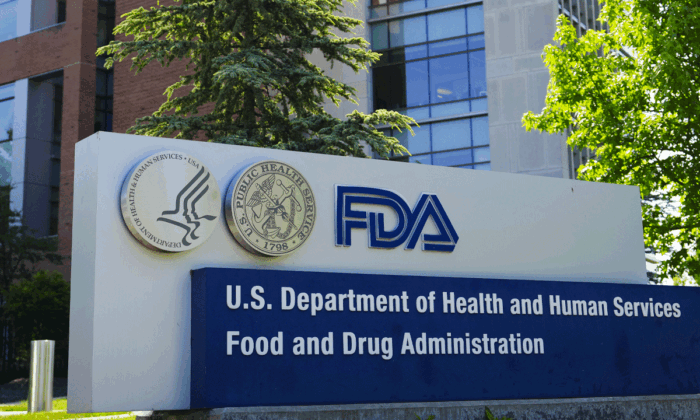The U.S. Food and Drug Administration (FDA) has warned consumers not to purchase or use certain eye drops from multiple major brands because of an elevated risk of developing a potentially serious eye infection.
The drops could lead to infections “that could result in partial vision loss or blindness” and that people with symptoms of eye infection after using the products “should talk to their health care provider or seek medical care immediately,” the agency said.
“These products are intended to be sterile,” the bulletin said. “Ophthalmic drug products pose a potential heightened risk of harm to users because drugs applied to the eyes bypass some of the body’s natural defenses.”
The agency said that it recommended that the maker of the eye products recall all lots on Oct. 25 following an inspection that found not sufficiently sanitary conditions in the manufacturing facility. FDA investigators also discovered “positive bacterial test results from environmental sampling” of production areas inside the facility.
While CVS, Rite Aid, and Target are now removing the products from their stores and websites, Leader, Rugby, and Velocity products might still be available online and in stores and shouldn’t be purchased, the FDA said.
The FDA said it hasn’t received any adverse incident reports associated with the products.
CVS Health
Lubricant Eye Drops 15 ml (single pack), Carboxymethylcellulose Sodium Eye Drops 0.5% w/vLubricant Eye Drops 15 ml (twin pack), Carboxymethylcellulose Sodium Eye Drops 0.5% w/v
Lubricant Gel Drops 15 ml (single pack), Carboxymethylcellulose Sodium Eye Drops 1% w/v
Lubricant Gel Drops 15 ml (twin pack), Carboxymethylcellulose Sodium Eye Drops 1% w/v
Multi-Action Relief Drops 15 ml, Polyvinyl Alcohol 0.5% w/v and Povidone 0.6% w/v and Tetrahydrozoline Hydrochloride 0.05% Eye Drops
Lubricating Gel drops 10 ml, Polyethylene Glycol 400 0.4% and Propylene Glycol 0.3% Eye Drops
Lubricant Eye Drops 10 ml (single pack), Propylene Glycol Eye Drops 0.6% w/v
Lubricant Eye Drops 10 ml (twin pack), Propylene Glycol Eye Drops 0.6% w/v
Rite Aid
Lubricant Eye Drops 15 ml (twin pack), Carboxymethylcellulose Sodium Eye Drops 0.5% w/vLubricant Eye Drops 10 ml (twin pack), Propylene Glycol Eye Drops 0.6% w/v
Gentle Lubricant Gel Eye Drops 15 ml, Hypromellose 0.3%, Glycerin 0.2%, Dextran 70 0.1% Eye Drops
Lubricant Gel Drops 15 ml, Carboxymethylcellulose Sodium Eye Drops 1% w/v
Lubricating Gel Drops 10 ml, Polyethylene Glycol 400 0.4% & Propylene Glycol 0.3% Eye Drops
Target Up&Up
Up&Up Dry Eye Relief Lubricant Eye Drops 30 ml, Polyethylene Glycol 400 0.4% & Propylene Glycol 0.3% Eye DropsUp&Up Extreme Relief Dry Eye 15 ml (single pack), Polyethylene Glycol 400 0.4% & Propylene Glycol 0.3% Eye Drops
Leader (Cardinal Health)
Dry Eye Relief 10 ml, Polyethylene Glycol 400 0.4% & Propylene Glycol 0.3% Eye DropsLubricant Eye Drops 15 ml (single pack), Carboxymethylcellulose Sodium Eye Drops 0.5% w/v
Lubricant Eye Drops 15 ml (twin pack), Carboxymethylcellulose Sodium Eye Drops 0.5% w/v
Dry Eye Relief 15 ml, Carboxymethylcellulose Sodium Eye Drops 1% w/v
Rugby (Cardinal Health)
Lubricating Tears Eye Drops 15 ml, Hypromellose 2910-0.3% w/v and Dextran 70- 0.1% Eye DropsVelocity Pharma
Lubricant Eye Drop 10 ml (triple pack), Propylene Glycol Eye Drops 0.6% w/vOther Incidents
Earlier this year, the U.S. Centers for Disease Control and Prevention (CDC) and FDA issued warnings about other eye drop products, including EzriCare Artificial Tears eye drops and Delsam Pharma’s Artificial Tears, due to potential bacterial contamination that was linked to more than a dozen cases of vision loss or eye removal. Four deaths also were reported.The CDC says on its website that the bacteria “is found commonly in the environment, like in soil and in water” and can cause a range of different types of infections targeting the blood, lungs, or parts of the body—especially “after surgery.”
“These bacteria are constantly finding new ways to avoid the effects of the antibiotics used to treat the infections they cause. Antibiotic resistance occurs when the germs no longer respond to the antibiotics designed to kill them,” the website says. “If they develop resistance to several types of antibiotics, these germs can become multidrug-resistant.
It isn’t known if the recent FDA warning and recall is linked to Pseudomonas aeruginosa.







